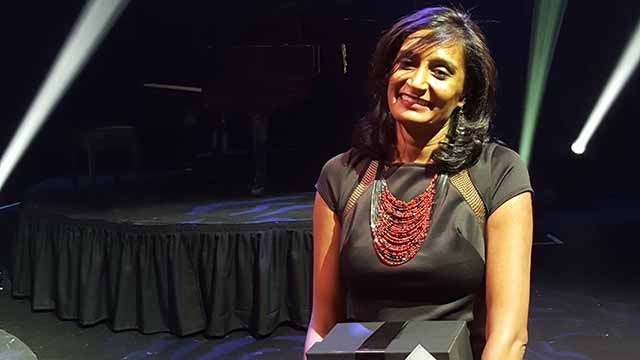
Rhodes University art history and visual arts senior lecturer Sharlene Khan was adorned with an award from the National Institute for the Humanities and Social Sciences (NIHSS) at the John Kani Market Theatre in Johannesburg on 15 March 2018.
The NIHSS is an independent statutory body for the development and co-ordination of scholarship research and ethical practices within the areas of humanities and social sciences, and its annual awards recognise and celebrate those members of this community who are undertaking the necessary work of creating post-apartheid and post-colonial forms of scholarship, creative production, and digital humanities outputs.
Khan was presented the Best Visual Art Award for her exhibition When the moon waxes red (2009-2017). Justice Dikgang Moseneke was also among this year’s winners, where he received the Best Non-Fiction Monograph Award for his book My Own Liberator.
Khan’s exhibition, influenced by the work of filmmaker Trinh Minh-ha, feminists bell hooks and Audre Lorde’s ideas of ‘bio-mythography’, textured narrativisation, and ‘insider-outside’ or ‘outsider-inside’ researching methodologies, to render her personal family stories as they migrated with the British Indentured Labour System in Durban, South Africa after 1860.
She was particularly inspired by her great grandmother, grandmother and mother’s tales as a working-class Indians who had moved from India to South Africa, one colonised country to another, and where they and the rest of the Indian community were confronted with an immensely racially hierarchical and patriarchal system.
Her mother’s narration of these relentless experiences and a poverty-stricken fate of the mid-1900s in Durban were encapsulated through various forms of text, images, and art work. These included needle-lace narratives, a video love letter, post-colonial masquerading photographs as well as oral tales of the struggles endured by Khan’s family. Through these forms of representations her mother also illuminated the hardships of working under indentured labour and the resilient nature of the migratory women immersed in these intolerant foreign settings.
The video piece draws on the powerful ability of women’s oral storytelling to challenge and interrogate generational patriarchal abuse. The personal narratives also formed a broader socio-historical description of the intersectionality between race, gender, class, religion, education, ethnicity as and how these were demonstrated in their everyday lives.
“Since June 2009, I have been learning to make needle-lace and using needle-lace motifs to depict symbols from my grandmother’s life. I have also been collecting women’s stories that end with burning, hanging or drowning,” said Khan.
The photographic series Drowning Durgas captures these using metaphorical visuals which act as signifiers to the desperate attempts for an escape and self-agency in women. By drawing metaphorically on the Hindu Festival ‘Durga Pooja’, where the goddess carries the sins of the congregation after a period of fasting and compliance, Khan does not return Durga to her husband but sets her free, to do with her body as she pleases.
She hence describes the essence of bio-mythography not as a polygraph, but as a showcase of the intricacies and ambiguities across postcolonial eras.